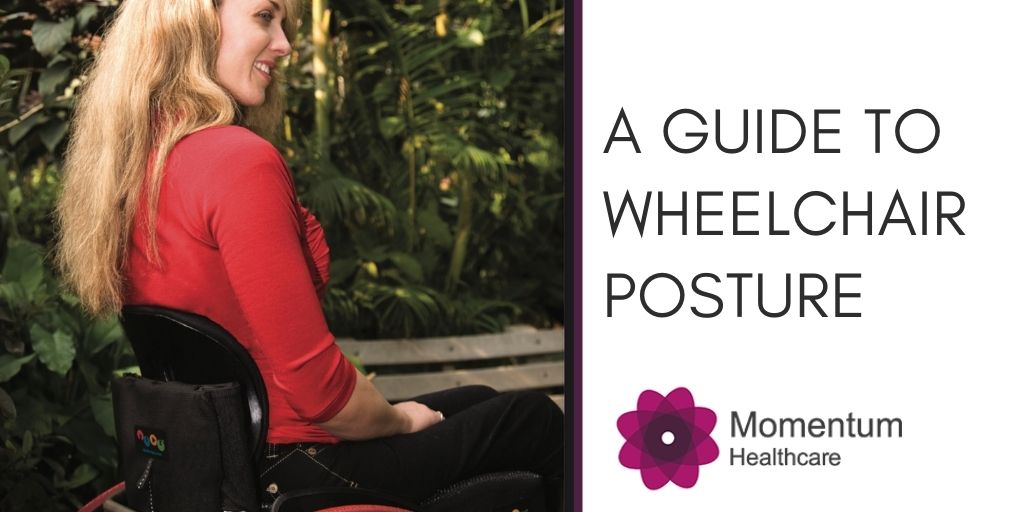Maintaining good posture while in a wheelchair is incredibly important to help those with limited mobility get around easily without risk of injury. Because wheelchair users spend their day sitting, there a number of crucial factors that are necessary to maintain good posture and enable the wheelchair user to feel comfortable and safe. When choosing a wheelchair, there should be a full assessment that includes measurements taken specific to the wheelchair user. An assessment will ensure that the wheelchair is set up for the person’s exact dimensions in order to ensure weight is evenly distributed. Here at Momentum Healthcare, we carry out seating and chair assessments with any purchase; you can contact us directly to book in an assessment. Here is our guide to wheelchair posture and the factors you need to take into account when investing in a new wheelchair.
Correct Seat Dimensions to Distribute Weight and Secure Pelvis
The seat of a wheelchair is one of the most vital parts for ensuring good posture and avoiding pressure sores. Not only should the seat feel comfortable to sit in, but it’s dimensions should be assessed so that the user does not slide or move about too much while moving. The seat in a wheelchair should not be too tight, but not too wide either. If the seat is wider than the person sitting in it, they will be moving and sliding around which can affect their posture and lead to injury. The weight of a person should be evenly distributed in the seat and the cushion should not sink or become squashed when it is being used. Ideally, the cushion in the seat of a wheelchair should be firm.
Wheelchair Backrest at a Suitable Height
The height of the wheelchair backrest is dependent on the person, how tall they are, and what they will be using the wheelchair for most. Higher backrests give those with limited mobility much more support and are effective in chairs where the seat can recline. However, depending on the person, a high backrest may not be suitable for their lifestyle and it can add more weight to the chair, making it more difficult to move around. If the wheelchair user does not require a high backrest for neck support or recline, a lower backrest can work well. Additionally, the width of the backrest should ensure the spine is supported; if the spine is not supported by the backrest there can be long-term injury. Luckily, the wheelchair user will be able to feel for themselves whether the backrest provides them with the support they need. If a wheelchair user feels discomfort after some time in their wheelchair it is important to carry out a re-assessment of the height, width and position of the seat. Caregivers can also assess the posture of the wheelchair user if they are unable to communicate.
Armrests are Essential to Easing Pressure from the Neck
Another factor to be taken into account when purchasing a wheelchair is the height of the armrests. There are a variety of armrests available, customised specifically for the user; some are height adjustable or can swing up or down. The height of the armrest should be suitable for the user to relax their arms without feeling tension or weight on their neck and arms. The armrest should also be comfortable so that it does not cause irritation to skin or dig into the arms.

Footrest Angle and Height for Hip and Leg Support
The footrest on a wheelchair provides support to both the hips and legs. Usually, the footrest sits at a 90 degree angle, however, in some cases the wheelchair user may require the footrest to be at a different angle depending on their condition and lifestyle. The footrest on a wheelchair should be at a height that supports the hips but is also high enough to avoid obstacles on the ground. Fortunately, wheelchair footrests are usually easily adjustable, which means they can be manually changed to the most comfortable position for the wheelchair user.
Sit Up Straight with Shoulders Back, if Possible
Maintaining good posture in a wheelchair is dependent on the measurements and position of each wheelchair feature. Every person is different, which is why wheelchairs must be customised to suit the customer and their requirements. Wheelchair users should also keep their shoulders back, and ensure their body is straight, not slumped to one side. If you can easily achieve this position then it is most likely your wheelchair is doing a good job at supporting you, but if you feel discomfort or it is not possible to sit back straight and evenly, you may need to have your wheelchair reassessed. Support for your lower back is essential; you should be able to put your weight in the middle of the seat, sit up straight and feel comfortable while moving around.
Momentum Healthcare are one of Ireland’s leading wheelchair experts, which is why we offer so many different types of wheelchair, aids and accessories to suit the requirements of a range of people. Our assessments ensure that our wheelchairs are perfectly suited to their user and provide enough support to maintain great posture. Find our products via our website today and get in touch with us at any time to book in your wheelchair assessment.


